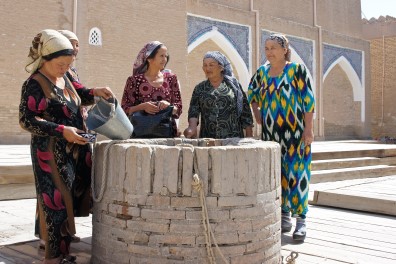1. What is the vision and mission of your organisation?
The formation of an environmental and water sound ideology, more activity of society in improving the environmental situation and water-saving in the region by disseminating information, improving water conservation and environmental literacy of population in the Zarafshan Valley.
Assistance in the implementation of government programmes on water supply in the Zarafshan River Basin through public involvement. Protection of the rights and interests of the population; organisation of public activity; solutions to urgent water problems in the region. To encourage people to save drinking water, and to use water efficiently through applying water saving technologies by water users in the agricultural sector.
2. Why did you decide to become a GWP Partner?
For centuries, the water management systems were ruled in an authoritarian style: from "top" - to "down". The government of the Republic made a decision to reorganize the management of water resources by applying the hydrographic principle. We joined the GWP network because GWP is a platform for management of IWRM knowledge, as well as for exchange of experience, what creates the IWRM potential.
All this creates a base to shift to water resources management by involving water users. Being a GWP partner, we have the possibility to update our IWRM knowledge and to attract public attention in addressing water management problems.
3. What have you found to be the benefits of being a GWP Partner?
IWRM give us possibility to coordinate various water users (municipal, industrial, power-producing and agricultural) under the water deficit in the Zarafshan Valley and to manage water resources more efficiently, and to allocate water fairly. It allows coordinating development and use of water resources too. Ideas and experience, which we obtained during events organised by GWP in Uzbekistan, became the basis for improving water resources management in the region. We have developed a number of proposals on IWRM and interlinking water users. We have held workshops with the participation of representatives of regional authorities, and water users from various sectors of the economy.
4. What is one challenge facing the management of water resources in your area of expertise?
For the Zarafshan Valley, where more than 7 million people are living, the only source of water is the Zarafshan river. A water resource per capita is less than 1200 cubic meters per year (in the Republic of Uzbekistan - 2000 cubic meters per year). We experience water scarcity throughout the year. The Zarafshan river is formed on the territory of a neighboring country. As the main source of water in the region, the river is essential for sustainable development of the economy and population of the whole river basin. The water scarcity of the Zarafshan River is a very serious problem, and it can not be solved only by more intelligent governance. But saying that "water problem in the region is not in its quantity, but in the management” is fair.
- The region is agricultural, and we must change cultivating plants: from water-resistance crops to drought-resistance ones, with low water requirements. We must actively implement water-saving technologies (drip irrigation, sprinkling etc) and shift management of river and main canals to a centralized remote (automated) way. We must also implement water measuring and gauging stations and discourage non-productive use of water and excessive water discharges that are due to imperfect water resources management.
5. Are there any special projects or initiatives that you would like more widely known?
Consider that the river flow on the territory of Uzbekistan is allocated between Samarkand, Kashkadarya, Navoi and Jizzakh regions. The project "Implementation of integrated management and measures of efficient use of water resources of the Zarafshan river" is being implemented under UN support and by decision of the Government of the Republic of Uzbekistan.
In the future, the following is needed:
Implementing of automation (SCADA) and supervisory service on water discharge data collecting, like in the BWO "Syrdarya";
- Organisational and technical improvement at the basin level;
- Establishing a stable system of financing and economic support;
- Interaction with regions, large water users, WUA; their involvement into the management of water resources under the conditions of openness and trust;
- Establish a public council on the Zarafshan river that includes representatives of the Republic of Tajikistan and Zarafshan Valley of Uzbekistan, and establishing a partnership with the Interstate Commission for Water Coordination.
Photo: Women by well in Uzbekistan.

